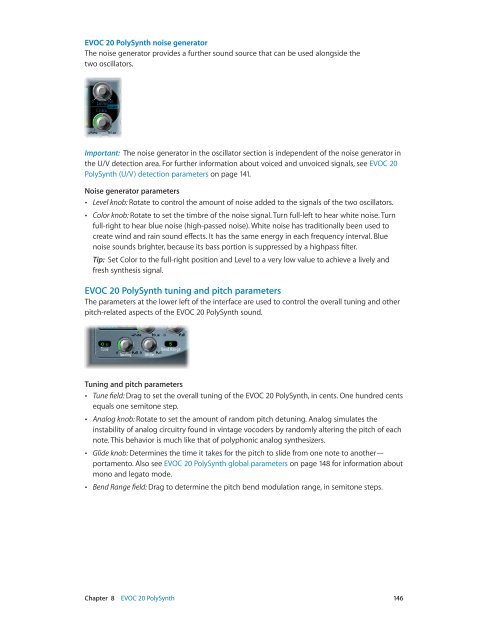Apple MainStage 3 Instruments - MainStage 3 Instruments
Apple MainStage 3 Instruments - MainStage 3 Instruments
Apple MainStage 3 Instruments - MainStage 3 Instruments
You also want an ePaper? Increase the reach of your titles
YUMPU automatically turns print PDFs into web optimized ePapers that Google loves.
EVOC 20 PolySynth noise generator<br />
The noise generator provides a further sound source that can be used alongside the<br />
two oscillators.<br />
Important: The noise generator in the oscillator section is independent of the noise generator in<br />
the U/V detection area. For further information about voiced and unvoiced signals, see EVOC 20<br />
PolySynth (U/V) detection parameters on page 141.<br />
Noise generator parameters<br />
••<br />
Level knob: Rotate to control the amount of noise added to the signals of the two oscillators.<br />
••<br />
Color knob: Rotate to set the timbre of the noise signal. Turn full-left to hear white noise. Turn<br />
full-right to hear blue noise (high-passed noise). White noise has traditionally been used to<br />
create wind and rain sound effects. It has the same energy in each frequency interval. Blue<br />
noise sounds brighter, because its bass portion is suppressed by a highpass filter.<br />
Tip: Set Color to the full-right position and Level to a very low value to achieve a lively and<br />
fresh synthesis signal.<br />
EVOC 20 PolySynth tuning and pitch parameters<br />
The parameters at the lower left of the interface are used to control the overall tuning and other<br />
pitch-related aspects of the EVOC 20 PolySynth sound.<br />
Tuning and pitch parameters<br />
••<br />
Tune field: Drag to set the overall tuning of the EVOC 20 PolySynth, in cents. One hundred cents<br />
equals one semitone step.<br />
••<br />
Analog knob: Rotate to set the amount of random pitch detuning. Analog simulates the<br />
instability of analog circuitry found in vintage vocoders by randomly altering the pitch of each<br />
note. This behavior is much like that of polyphonic analog synthesizers.<br />
••<br />
Glide knob: Determines the time it takes for the pitch to slide from one note to another—<br />
portamento. Also see EVOC 20 PolySynth global parameters on page 148 for information about<br />
mono and legato mode.<br />
••<br />
Bend Range field: Drag to determine the pitch bend modulation range, in semitone steps.<br />
Chapter 8 EVOC 20 PolySynth 146
















